Book now
So much to see and so little time! Spend the night in Bruges or take a guided tour.
20 historical sites to visit in Bruges
Bruges, the capital of West Flanders in Belgium, is a city steeped in history and charm. With its well-preserved medieval architecture, picturesque canals, and cobbled streets, it’s no wonder that Bruges has been dubbed the “Venice of the North”. As one of the most well-preserved medieval cities in Europe, Bruges has a wealth of historical sites that offer a glimpse into its rich cultural past. In this article, we will take a closer look at some of the most significant historical sites in Bruges, each with its unique story to tell. So, let’s step back in time and explore the fascinating history of this enchanting city.
Short of time to read the whole article? Go directly to your favorite item via the table of contents.
1 Basilica of the Holy Blood
The Basilica of the Holy Blood is one of the most visited historical sites in Bruges. Located in the heart of the city’s medieval center, the basilica is famous for housing a venerated relic – a phial containing what is said to be a cloth with a few drops of the actual blood of Jesus Christ.
The basilica is actually two chapels in one building, with the lower chapel being a Romanesque-style structure that dates back to the 12th century. The upper chapel, which houses the holy relic, was built in the Gothic style in the 16th century.
The basilica is open to the public, and visitors can view the holy relic in the upper chapel during designated times throughout the day. The interior of the chapel is richly decorated, with colorful stained glass windows, intricate carvings, and elaborate murals.
Aside from the religious significance of the relic, the Basilica of the Holy Blood is also a masterpiece of medieval architecture and a testament to the artistic and spiritual heritage of Bruges. A visit to this historical site is a must for anyone interested in exploring the rich cultural and religious history of the city.
Location: Burg 13











2 Belfry (Belfort)
The Belfry of Bruges is a towering medieval bell tower that stands in the heart of the city’s historic center. The tower, which dates back to the 13th century, was originally built as a symbol of the city’s wealth and independence.
At 83 meters tall, the Belfry is one of the tallest structures in Bruges, and its impressive silhouette dominates the city’s skyline. Visitors can climb the 366 steps to the top of the tower for panoramic views of the city and the surrounding countryside.
Aside from its impressive height and views, the Belfry also has a rich history. It was used as a watchtower and bell tower, and the bells were used to signal important events such as fires, enemy attacks, and curfews. Today, the bells still ring out every quarter hour, and visitors can see the impressive clock mechanism in action.
The Belfry is a UNESCO World Heritage site and a must-visit attraction for anyone interested in medieval architecture and history. It’s an iconic symbol of Bruges and a testament to the city’s rich cultural heritage.
Location: Markt 7


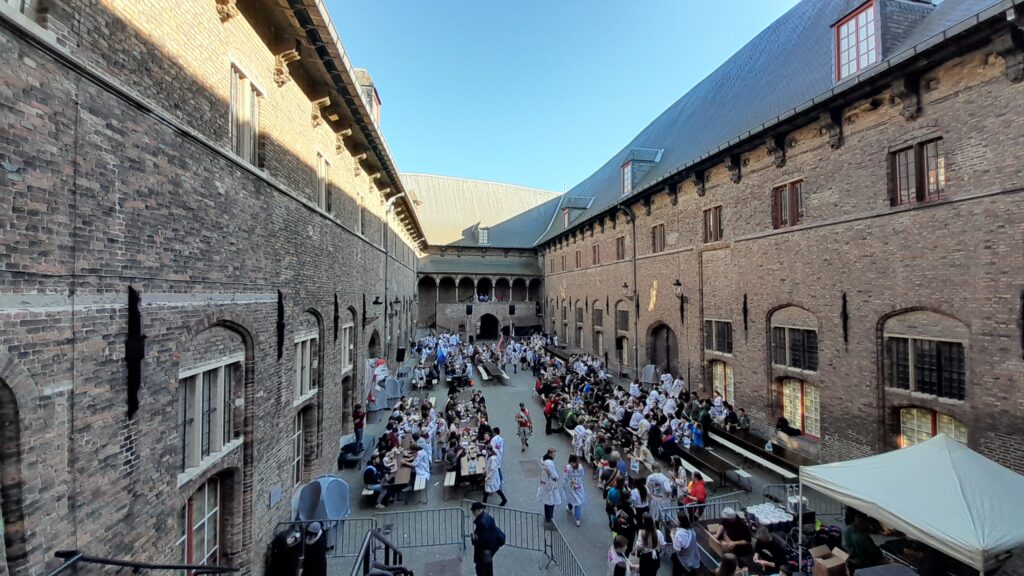



3 City Hall
The City Hall of Bruges, also known as the Stadhuis, is a stunning example of Gothic architecture and one of the city’s most recognizable landmarks. Built in the 14th and 15th centuries, it served as the administrative center of the city and the seat of the municipal government.
The City Hall is located on the Burg, which is the historic square at the heart of the city. It features a magnificent façade with ornate carvings, statues, and reliefs that depict scenes from the city’s history.
Inside, visitors can explore a series of richly decorated rooms that have been preserved in their original medieval and Renaissance-era style. Some of the highlights include the Gothic Hall, which features a breathtaking vaulted ceiling and stained glass windows, and the Aldermen’s Chamber, which is decorated with elaborate murals and tapestries.
Location: Burg 12




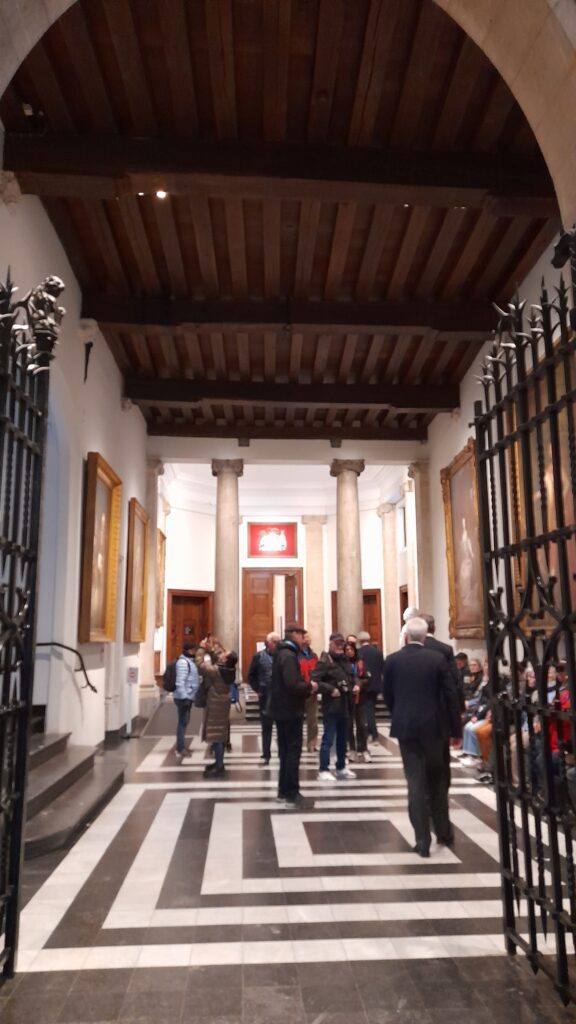

4 Smedenpoort (Blacksmith’s Gate)
Smedenpoort, also known as the Blacksmith’s Gate, is one of the four remaining gates of the medieval city walls of Bruges. Built in the 13th century, it served as an entrance to the city for merchants and travelers arriving from the east.
The gate is named after the blacksmiths who once plied their trade in the area outside the gate. Today, the gate is a popular tourist attraction and a testament to the city’s rich architectural heritage.
Smedenpoort is an important part of Bruges’ cultural heritage and a fascinating reminder of the city’s medieval past.
Location: Smedenpoort
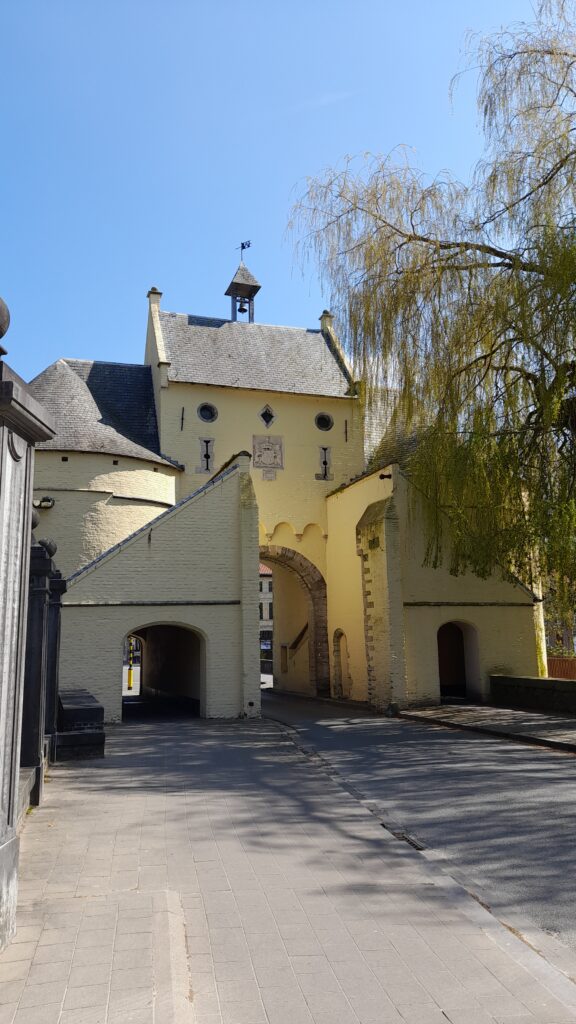





5 Godshuis Marius voet
Godshuis Marius Voet is a historic almshouse located in the heart of Bruges. It was founded in the 17th century by Marius Voet, a wealthy merchant and philanthropist, as a home for elderly and sick citizens who were in need of assistance.
Today, the almshouse is still in use, providing affordable housing for elderly residents of Bruges.
Godshuis Marius Voet is a fascinating insight into the history of social welfare in Bruges and a reminder of the importance of philanthropy and community support.
Location: Kammakerstraat 13


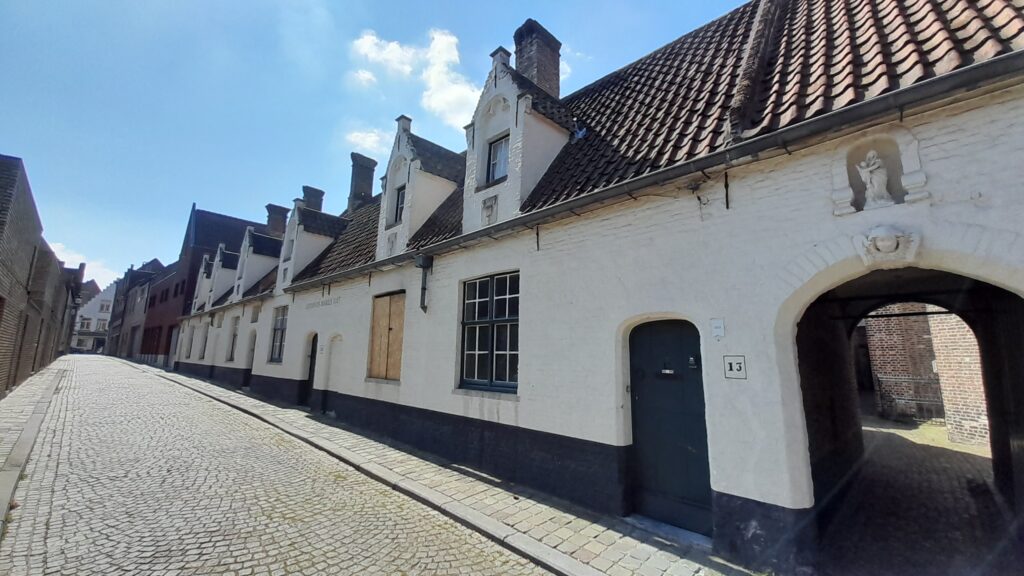



6 St Saviour’s Cathedral (Sint Salvatorskathedraal)
St. Saviour’s Cathedral, also known as Sint Salvatorskathedraal, is a Gothic-style cathedral located in the historic city of Bruges. It is the oldest parish church in the city, with its origins dating back to the 10th century. The cathedral has undergone many renovations and additions over the centuries, resulting in its current appearance.
One of the notable features of the cathedral is its tower, which stands at 99 meters tall and can be seen from many parts of the city. The tower was originally built in the 12th century but was destroyed and rebuilt several times throughout history, with the current tower dating back to the 19th century.
Inside the cathedral, visitors can see a variety of religious art and artifacts, including a number of valuable paintings, sculptures, and tapestries. One of the most notable works of art in the cathedral is a wooden sculpture of the Madonna and Child, which is believed to date back to the 13th century.
Today, St. Saviour’s Cathedral remains an important religious and cultural landmark in Bruges, attracting visitors from all over the world who come to admire its stunning architecture and learn about its rich history.
Location: Steenstraat




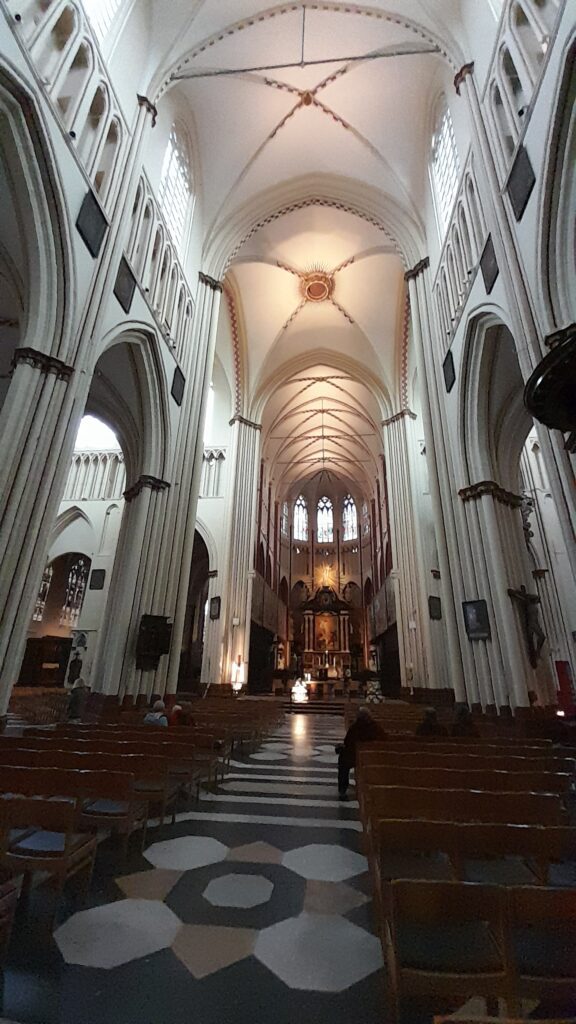

7 Treasury St. Saviour’s Cathedral
St. Saviour’s Cathedral has a treasury that houses a collection of religious artifacts and precious objects. The treasury is located in the chapel of the Holy Blood, which is a part of the cathedral.
Some of the most notable items in the treasury include a reliquary that contains a fragment of the True Cross, a 12th-century processional cross, a silver-gilt chalice that dates back to the 14th century, and a number of ornate vestments and tapestries.
One of the most important items in the treasury is the Reliquary of St. Ursula, which is a silver reliquary that contains the bones of the legendary saint. The reliquary is adorned with intricate carvings and precious stones and is considered to be one of the finest examples of medieval goldsmith work in Belgium.
Visitors to the treasury can also see a collection of illuminated manuscripts, including a 15th-century Book of Hours that is believed to have been commissioned by Philip the Good, Duke of Burgundy.
The treasury at St. Saviour’s Cathedral offers visitors a unique opportunity to see some of the most important religious and historical artifacts in Bruges and provides a fascinating insight into the rich cultural heritage of the city.
Location: Steenstraat inside Cathedral




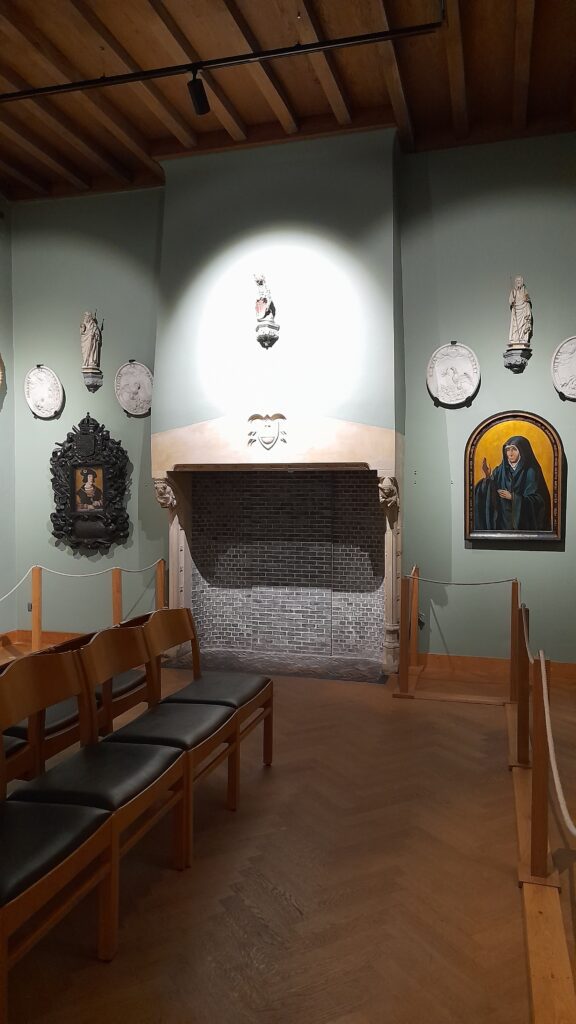

8 O.L.V.-kerk Museum (Museum of the Church of Our Lady)
The O.L.V.-kerk Museum, also known as the Museum of the Church of Our Lady, is a museum located in the Church of Our Lady (Onze-Lieve-Vrouwekerk) in Bruges, Belgium. The museum is dedicated to preserving and showcasing the church’s impressive collection of religious art and artifacts.
One of the most famous works of art in the museum is Michelangelo’s marble sculpture of the Madonna and Child, which is considered to be one of the most valuable art pieces in Belgium. The sculpture was originally intended for the cathedral in Siena, Italy, but was acquired by a wealthy merchant from Bruges in the 16th century and later donated to the Church of Our Lady.
In addition to the Michelangelo sculpture, the museum also houses a collection of other valuable works of art, including several paintings by Flemish masters such as Jan van Eyck and Hans Memling, as well as a number of impressive tapestries.
Visitors to the museum can also see a collection of liturgical objects, such as chalices, monstrances, and reliquaries, which offer a glimpse into the rich history of the Church of Our Lady and its role in religious life in Bruges.
Overall, the O.L.V.-kerk Museum is a must-see attraction for art lovers and anyone interested in the history and culture of Bruges. With its impressive collection of religious art and artifacts, the museum provides a unique opportunity to explore the rich artistic heritage of this historic city.
Location: Mariastraat






9 Bonifaciusbrug (Boniface Bridge)
The Bonifaciusbrug, or Boniface Bridge in English, is a picturesque bridge located in the heart of Bruges, Belgium. The bridge spans the Groenerei, a scenic canal that winds its way through the historic city center.
The bridge is named after Saint Boniface, who was a Christian missionary and martyr in the 8th century. It is a small stone bridge with a single arch, and it is considered to be one of the most charming and photogenic spots in Bruges.
The Bonifaciusbrug offers a beautiful view of the canal and the surrounding historic buildings, including several old merchant houses that date back to the 16th and 17th centuries. The area around the bridge is also home to a number of quaint cafes and restaurants, making it a popular spot for tourists to relax and enjoy the scenery.
The bridge is particularly stunning at night when it is illuminated by the warm glow of the streetlights and the reflections in the canal. It is a popular spot for photographers and is often featured in travel guides and postcards.
The Bonifaciusbrug is a must-see attraction for anyone visiting Bruges. With its stunning views, it is a great place to take a stroll and soak up the atmosphere.
Location: Groeninge 6






10 Saint-John’s Hospital (Sint-Janshospitaal)
Saint-John’s Hospital, or Sint-Janshospitaal in Dutch, is a historic hospital located in the city of Bruges, Belgium. The hospital was founded in the 12th century and is one of the oldest surviving hospital buildings in Europe.
Today, the hospital has been converted into a museum that showcases the history of medicine and healthcare in Bruges. Visitors can explore the hospital’s various rooms and see how medical treatments were carried out in the Middle Ages and the Renaissance.
One of the most impressive features of the hospital is its collection of artworks, which includes paintings by some of the most famous Flemish artists, including Hans Memling and Gerard David. Many of these works were commissioned by the hospital’s wealthy patrons and were intended to provide comfort and inspiration to the sick and dying.
Visitors can also see a collection of medical instruments and equipment, including surgical tools, apothecary jars, and even an early X-ray machine. The hospital’s pharmacy is particularly impressive, with rows of wooden cabinets filled with jars of medicinal herbs and powders.
One of the most interesting parts of the museum is the old hospital ward, where visitors can see how patients were cared for and treated in the past. The ward includes rows of wooden beds and a series of paintings depicting various medical procedures, such as bloodletting and amputation.
Overall, the Saint John’s Hospital museum offers a fascinating glimpse into the history of medicine and healthcare in Bruges and is a must-see attraction for anyone interested in the city’s rich cultural heritage.
Location: Mariastraat 38












11 Godshuis De Meulenaere St-Jozef
“Godshuis De Meulenaere St-Jozef” is a historic building located in the city of Bruges, Belgium. It was built in the 17th century as a charitable institution for the elderly, funded by the De Meulenaere family. The building’s architecture is characterized by its gable roof and Flemish Renaissance style.
Today, the building serves as a home for the elderly, providing care and accommodation for those in need. It is a testament to Bruges’ rich history and commitment to providing social services to its citizens.
Location: Nieuwe Gentweg 8






12 Begijnhof (Beguinage)
The ‘Princely Beguinage Ten Wijngaarde’ is a well-preserved and picturesque Beguinage located in Bruges, Belgium. It was founded in the 13th century and was originally intended for the housing and care of Beguines, lay religious women who lived in a semi-monastic community.
The Beguinage consists of a series of white-washed houses arranged around a central green courtyard, which includes a small chapel dedicated to St. Elizabeth of Hungary. The houses are typical of the Flemish style of architecture, with stepped gables and red-tiled roofs.
Today, the Beguinage is a UNESCO World Heritage Site and is home to a small community of Benedictine nuns who continue the tradition of quiet contemplation and prayer that has characterized the site for centuries. The Beguinage is open to the public and visitors can stroll through the tranquil gardens and pathways, admiring the architecture and the peaceful atmosphere.
Location: Begijnhof 24


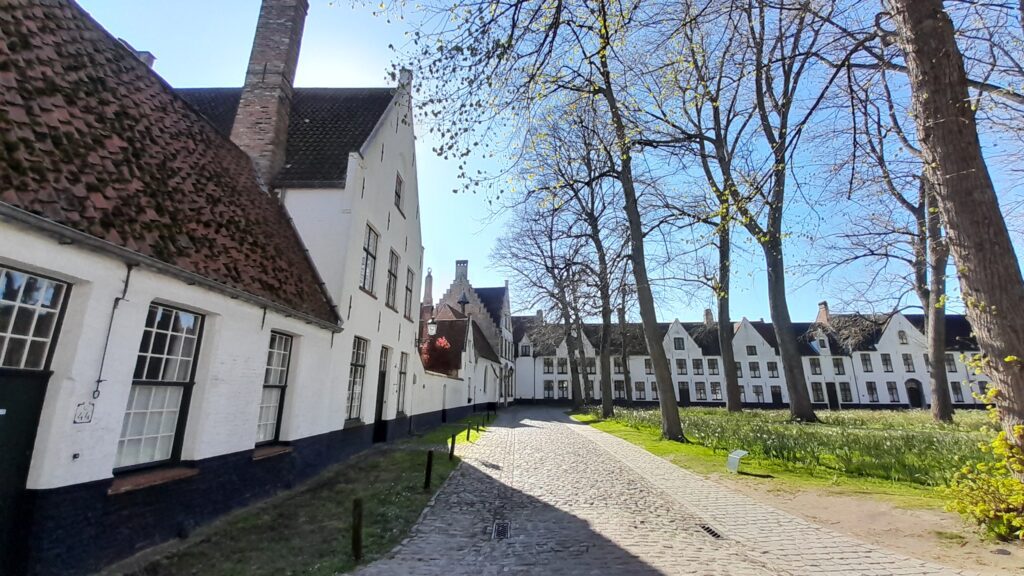









13 Minnewater (Lake of Love)
Minnewater is a picturesque lake located in the south of the city center of Bruges, Belgium. It is also known as the “Lake of Love” and is a popular tourist attraction in the city.
Today, Minnewater is a peaceful place to stroll and take in the beautiful surroundings. Visitors can walk along the paths around the lake, take a boat ride, or simply relax on the grass and enjoy the view. The area is particularly popular in the spring when the nearby park is filled with blooming flowers. It is a beautiful and romantic spot in the heart of Bruges, and a must-visit for any traveler to the city.
Location: Minnewater
14 Provinciaal Hof (Provincial Court)
The Provinciaal Hof, also known as the Provincial Court, is a historic building located on the Markt (Market Square). It was built in the neo-gothic style between 1887 and 1921, and was designed by the architect Louis Delacenserie.
The Provinciaal Hof was originally used as a meeting place for the provincial council of West Flanders, and later served as a courthouse. Today, it is used primarily for ceremonial purposes and is a popular venue for concerts, exhibitions, and other cultural events.
The building is characterized by its tall, pointed towers, intricate stonework, and stained glass windows. The facade is adorned with statues of important figures from Flemish history, including Count Baldwin IX and Philip the Good. Visitors can enter the Provinciaal Hof and admire the grand interior, including the impressive staircase and ornate ceilings.
The Provinciaal Hof is a landmark of Bruges and a testament to the city’s rich architectural heritage. It is also an important cultural center, playing host to a wide range of events and exhibitions throughout the year.
Location: Markt 3
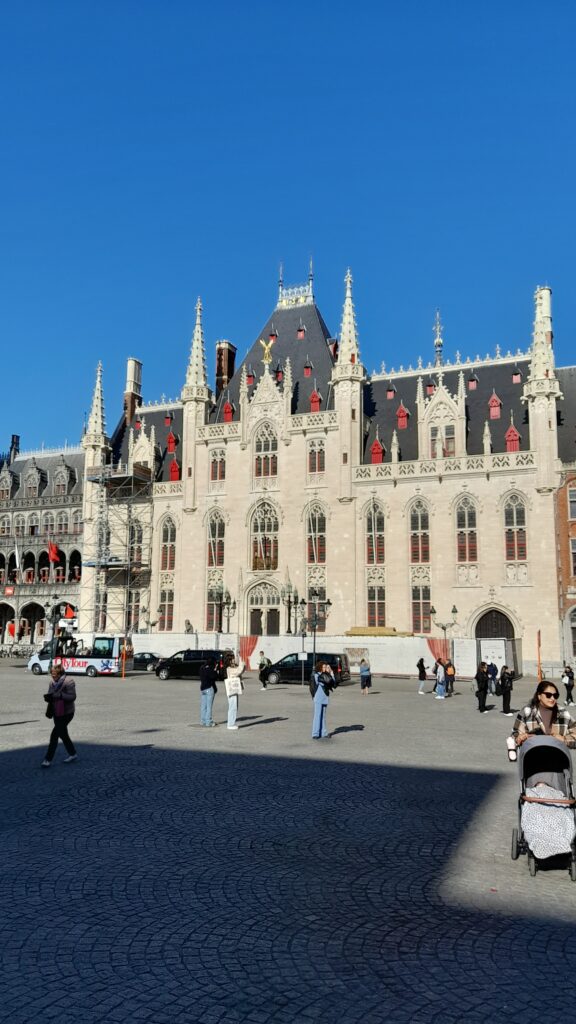

15 Historium Bruges
Historium Bruges is a historical and cultural attraction located in the heart of Bruges. It is a multimedia experience that allows visitors to step back in time and experience the city’s medieval history and culture.
The experience begins with a guided tour through a recreated medieval building, which introduces visitors to the sights, sounds, and smells of medieval Bruges. From there, visitors can explore a series of interactive exhibits, including virtual reality displays, 4D cinema, and hands-on activities that bring the city’s history to life.
One of the highlights of the Historium is the “Historium Story,” a short film that immerses visitors in the world of a young man named Jacob, who arrives in Bruges in the 15th century. The film is accompanied by stunning visuals and special effects, making visitors feel as though they are a part of Jacob’s journey.
In addition to the interactive exhibits, the Historium also features a gift shop and a bar that offers traditional Belgian beers and snacks. It is a popular attraction in Bruges, particularly for those interested in history, culture, and technology.
Location: Markt 1


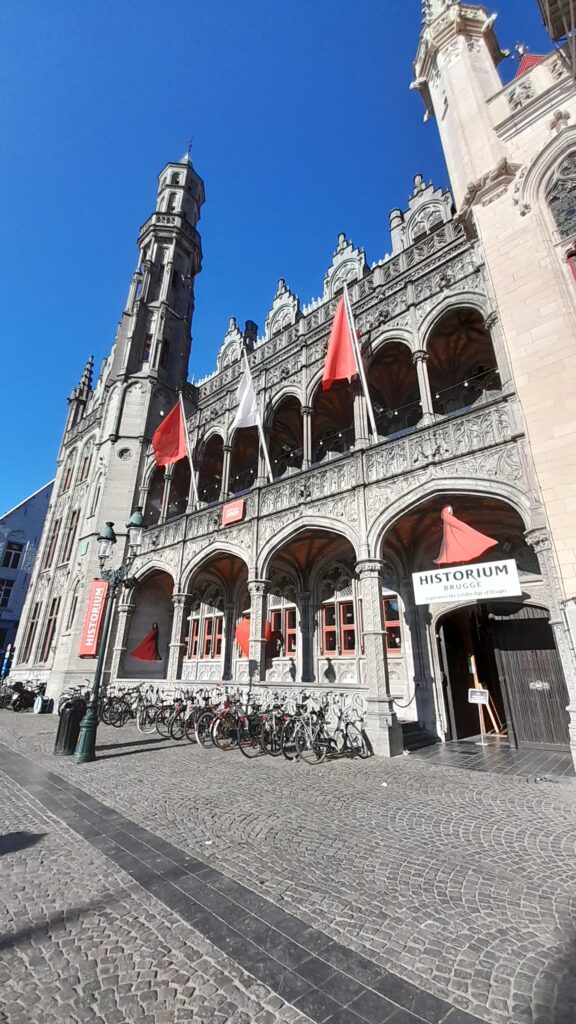

16 Gentpoort (Gate of Ghent)
The Gentpoort, also known as the Gate of Ghent, is a historic gatehouse located in Bruges. It is one of the four remaining gates that once provided access to the city during the Middle Ages.
The Gentpoort was built in the 14th century as part of the city’s defensive walls. It was originally used to regulate access to the city from the north, particularly from the city of Ghent. The gatehouse is characterized by its imposing brick walls, pointed arches, and turrets.
Today, the Gentpoort is open to visitors as a museum of medieval life and architecture. The museum features a series of exhibits that explore the history of the city’s defensive walls, as well as the daily life of the people who lived in Bruges during the Middle Ages. Visitors can climb the tower to enjoy panoramic views of the city and the surrounding countryside.
The Gentpoort is a testament to the city’s rich history and a reminder of its strategic importance as a trading center during the Middle Ages. It is a popular destination for visitors to Bruges who are interested in history and architecture.
Location: Gentpoortvest


17 Windmills of Bruges
The windmills of Bruges are a group of four historic windmills located on the eastern edge of the city. They are some of the best-preserved examples of traditional windmills in the Flanders region of Belgium.
The windmills were built in the 18th century and were originally used to grind grain and pump water. They were an important part of the city’s economy, providing the power needed to produce flour and other goods.
Today, three of the four windmills are still in operation and can be visited by tourists. Visitors can climb to the top of the windmills to enjoy panoramic views of the city and the surrounding countryside. Inside the windmills, visitors can see the original grinding mechanisms and other equipment that was used to produce flour.
The windmills are located in a picturesque park, making them a popular destination for visitors who are looking to relax and enjoy the natural beauty of the area. The park also features walking paths, a picnic area, and a playground for children.
The windmills of Bruges are an important part of the city’s cultural heritage and a symbol of its industrial past. They offer visitors a unique glimpse into the history of the region and are a must-see destination for anyone visiting Bruges.
Location: Kruisvest




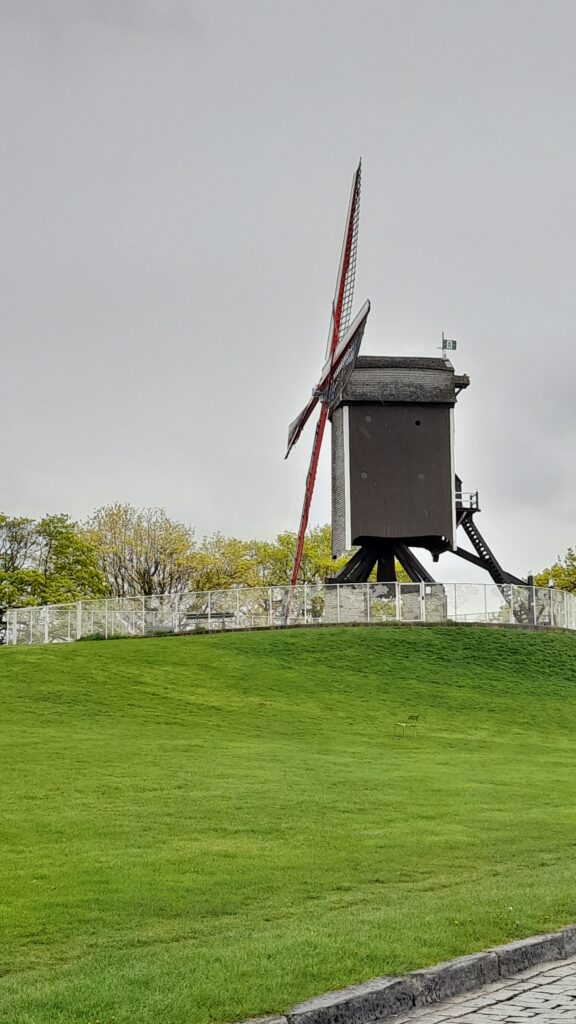

18 Ezelpoort (Donkey’s gate)
Ezelpoort, also known as the Donkey’s Gate, is a historic gate located in the city of Bruges, Belgium. It is one of the four surviving gateways that once allowed access to the medieval city.
The gate was originally built in the 13th century as part of the city’s defensive walls. It was reconstructed in the 16th century in the Renaissance style, and it has been restored several times since then.
Today, the Ezelpoort is a popular tourist attraction and is considered one of the most beautiful and best-preserved gates in Bruges. Visitors can walk through the gate and explore the surrounding area, which includes a picturesque canal and several historic buildings.
Location: Ezelpoort






19 Kruispoort (Kruispoort gate)
Kruispoort, also known as the Cross Gate, is one of the four remaining medieval gates of the city of Bruges. It is located on the northwestern side of the city and is believed to have been built in the early 15th century.
The gate was constructed as part of the city’s defensive walls and was used as a way to control access to the city.
Kruispoort is a striking example of Gothic architecture and is well-preserved. It features two large towers with spires and a central archway that allowed entry to the city.
Today, Kruispoort is a popular tourist attraction and is also used as a backdrop for cultural events and festivals in Bruges.
Location: Langestraat 191


20 Poortersloge
The Poortersloge is a historic building located in the city of Bruges. It was originally built in the late 15th century as a meeting place for the city’s wealthy merchants and tradespeople, known as the Poorters.
The Poortersloge was used as a gathering place for the Poorters to discuss civic affairs and to host important guests. It was also used as a marketplace for luxury goods and as a place for public ceremonies and celebrations.
The building was extensively renovated in the 19th century and today it houses the Bruges city archives. Visitors can tour the archives to learn about the city’s rich history and view important documents and artifacts.
The Poortersloge is also used as a cultural center and is home to several art exhibitions throughout the year. The building’s impressive architecture and historical significance make it a popular tourist destination in Bruges.
Location: Kraanlei 19
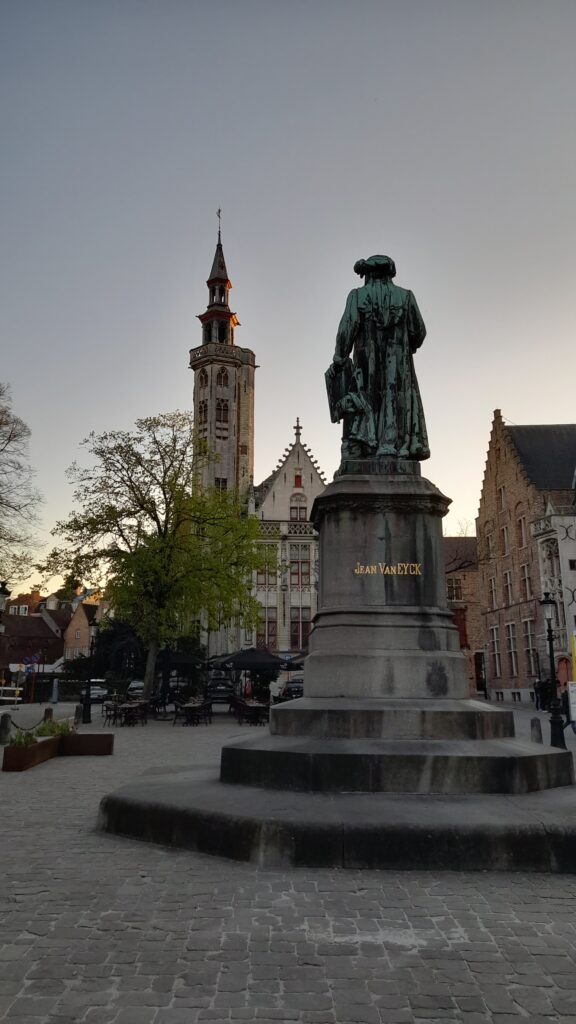



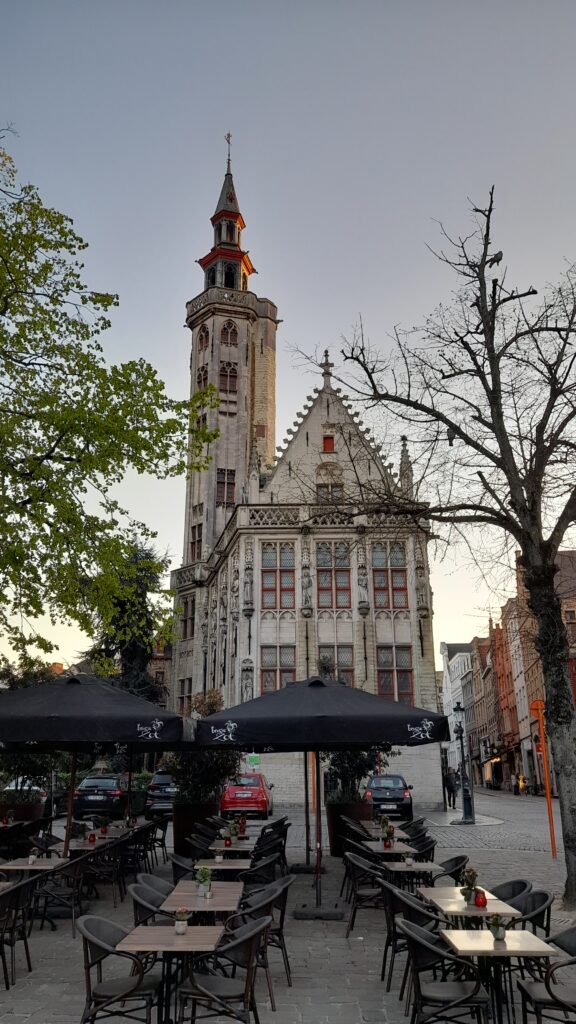

People also read:
Book a guided tour
More usefull information and links
Get more out of your visit by searching and exploring the following information and website links
- Belfry of Bruges (Belfort)
- Grand Place (Grote Markt)
- Bruges Canal Boat Tours
- Markt Square (Markt)
- Church of Our Lady (Onze-Lieve-Vrouwekerk)
- Bruges City Hall (Stadhuis)
- Groeningemuseum
- Burg Square (Burg)
- The Beguinage (Begijnhof)
- Bruges Museum – Historium
- Choco-Story Bruges
- The Frietmuseum
- The Medieval Torture Museum
- Bruges Windmills
- Sint-Salvators Cathedral
- The Belgian Beer Museum
- Minnewater Lake (Lake of Love)
- Arentshuis Museum
- Diamantmuseum Bruges
- Brouwerij De Halve Maan (Half Moon Brewery)
- Torture Museum
- Bruges Art Museum
- Museum of the Holy Blood (Heilig-Bloedbasiliek)
- Ezelpoort (Donkey Gate)
- Hansa Brewery
- Loppem Castle (Kasteel Loppem)
- Historium Bruges
- Bruges Diamond Museum
- Kruispoort (Cross Gate)
- Museum of Musical Instruments
These additional links provide more options for exploring Bruges and experiencing its rich cultural and historical offerings.
FAQ
written by Johnny
This article may contain affiliate links. This means that we receive a small commission when you book something via these links. Of course, this does not cost you anything extra. Did our tips help you? We would love it if you book your trip via the links in the article above. Thank you so much
Read more articles on my Bruges page.


